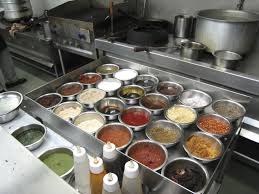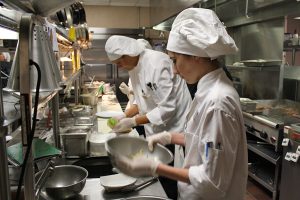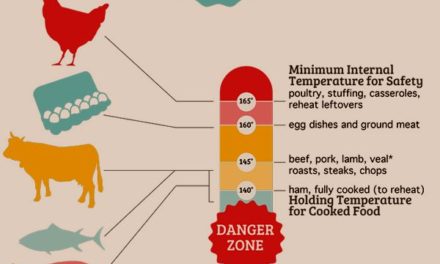As an experienced professional, people always ask me what makes a good chef. There is no simple answer as a good chef possesses numerous skills. This is the fourth in my series of articles addressing those skills. Part 1 covered knives. Other skills include palate, plating, and managerial ability. Today I’m talking about Organization, how chefs keep their kitchens cleaned, organized, and running smoothly through ordered chaos
There is a control freak in every chef. I don’t care how humble, how calm they may appear, chefs like order. Floors must be clean, stainless steel tables should sparkle, not a speck of dust or dirt anywhere. Food belongs in containers lined up on shelves that get wiped down every day. Walk-ins to be filled with trimmed and unblemished produce, meats, and dairy. This is the best kind of kitchen. The kind you see on television. Gordon Ramsey is a control freak. So am I.
Ground Control

But why? With everything else a chef has to deal with in a restaurant – pirate crews, whiney servers, managers who need attention, diners who want the chef to come out and talk to them – chefs must have order when it comes to product. We do it because there are rules.
There are health inspectors that show up regularly. We know that we can make people sick if we don’t pay attention. A cook has a sacred trust with their patron. The government official is the check and balance for a chef to stay on target with that trust.
Cleanliness and order is expected during prep time, when food is being cooked, while produce is chopped, sliced, diced and otherwise transformed, and while the equipment is used to its capacity. This is the time when a chef has to be diligent with the crew. A watchful eye and discipline when a cook steps out of line keeps the restaurant on target with delivering excellent service to the diner.
At any moment someone, anyone, could come back to the kitchen and see into the Chef’s world. The owner, a diner, the health inspector, hell, the President (yes, I have cooked at events for the President as well as for all levels of government officials), celebrities, and rock stars. And that’s the moment you want every single thing glistening, the crew decked out in their best, the dish pit clear. Without this part of organization a kitchen can turn into a pit of doom. I’ve worked in those places with dingy walls and grease covered stove tops. If you step into my kitchen and random chaos reigns, I will lose you as a customer.
Uber-Clean Freak
I care about organization and cleanliness because that’s how I was taught. As a young cook I learned this particular skill set. I had the good fortune to be under the tutelage of a Kitchen Manager 30 years my senior while working in a deli.
Organization in a deli is vital to its ability to rapidly produce sandwiches. You need all the meats, cheeses, veggies, condiments, and breads ready as well as the side salads and soups, otherwise you’ll be overwhelmed when the lunch rush arrives, chaos will rule supreme, and that will reflect on service to the customer.
Rotating product is essential to ensure the freshest ingredients are at hand. That’s where labeling and dating everything matters and making sure that the old stuff gets thrown out in a timely fashion. What makes or breaks a deli is the freshness.
That manager drilled cleanliness into my routine until it was almost an instinct. I was not allowed to leave until the entire back of the kitchen was cleaned. For three months she double-checked my work before trusting that I could do the job by myself.
I carry those organizational and cleaning skills to this day. When a cook tells me they won’t clean out a fryer that’s when I fire them. I’ve drained and cleaned my fair share of these smelly, grease-laden work horses. I’ve reached into the dark corners of kitchens and I’ve won the battle of grease.
Order Out of Chaos
 There are other aspects to organizing a kitchen. Once service starts the line has to be ready. Every station cook has their mis-en-place, enough food to hopefully get through the entire evening. The product is fresh and robust. The cooks set with their game faces. The expeditor’s line is clean and sparkling. Dishes are filled to the brim, plate wipes ready, the ticket machines loaded with paper and ready to start spitting out orders to cooks.
There are other aspects to organizing a kitchen. Once service starts the line has to be ready. Every station cook has their mis-en-place, enough food to hopefully get through the entire evening. The product is fresh and robust. The cooks set with their game faces. The expeditor’s line is clean and sparkling. Dishes are filled to the brim, plate wipes ready, the ticket machines loaded with paper and ready to start spitting out orders to cooks.
This is the ready set stage. The moment when the crew shines. If the prep cooks did their jobs and kept organized during the day, then the dinner chefs can crank out plate after plate without fail. This is the ideal kind of night for a chef, when it all goes right.
Without diligence in organization, this is the exact moment where a kitchen can break down. Have you had that experience, sitting in a restaurant and your order has already been delivered to the kitchen, but a half an hour has passed with no explanation? You know that the pasta doesn’t take a half an hour to cook. Back in the kitchen there wasn’t enough sauce or vegetables and the line cook had to step back and do the prep’s job, resulting in the wait. The organization of prep in a kitchen relies on sheets with ingredients that need to be made. If these lists aren’t checked off, then you, the diner, suffer. This is one of a number of factors at play without the eye of watchfulness during prep hours.
And that’s just an example from a dinner-only restaurant.
 Imagine a full service restaurant that churns out breakfast, lunch, and dinner. More than 1,200 covers a day go out the door — that’s easily 12,600 pounds of food per day. Someone has to organize all that food coming into the restaurant. Deliveries start early. I worked at one deli where I had to be there at 5:45 a.m. for the first truck. Some of these restaurants are small with 1,000 square feet of storage space. It becomes a game of Tetris. Where can I put all the food I need to get through a day of service? Not everyone can slot thousands of pounds of food into such a small space, but if the kitchen is kept clean and organized this becomes an easy task.
Imagine a full service restaurant that churns out breakfast, lunch, and dinner. More than 1,200 covers a day go out the door — that’s easily 12,600 pounds of food per day. Someone has to organize all that food coming into the restaurant. Deliveries start early. I worked at one deli where I had to be there at 5:45 a.m. for the first truck. Some of these restaurants are small with 1,000 square feet of storage space. It becomes a game of Tetris. Where can I put all the food I need to get through a day of service? Not everyone can slot thousands of pounds of food into such a small space, but if the kitchen is kept clean and organized this becomes an easy task.
The next time you are eating out, look around at what is happening in that restaurant. Is it somewhere big? A place that sacks out hundreds of plates a day or a mid-size restaurant that serves lunch and dinner or a small intimate dinner that serves food from 5-9 p.m. For any of these restaurants the driving force is organization – and a crew of cooks that have scoured and scrubbed as much as sliced and diced – that makes it possible for you to enjoy your meal.






